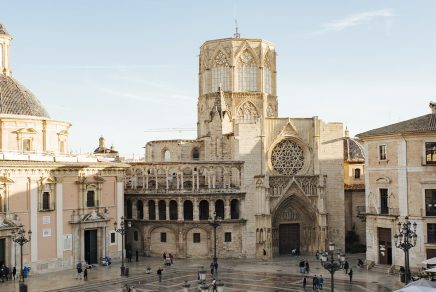Dali’s works can be seen in various museums, such as the Museo Nacional Centro de Arte Reina Sofía (MNCARS) in Madrid. But to get to know this eccentric character better, you have to go to the Costa Brava in Catalonia.
As you approach the theatre-museum that bears his name in Figueres, near Cadaqués, you may wonder about the strange dots that decorate one of the façades. Tiny Buddhas? Giant popcorn kernels? Hanging dots? Actually, they are little ceramic buns designed to give you… goosebumps. Welcome to the world of Dali!
Created entirely by the surrealist artist, it houses 1,500 works and attracts 1,250,000 visitors every year. When you enter this former ruined theatre that Dali brought back to life, you feel as if you are entering the mind of the artist. You are greeted by mannequins reminiscent of the Oscars, which watch the visitors.
In another room, more classical paintings give an insight into his early steps in the world of painting. From room to room, you get to know both the work and the man behind it. Delirium and madness are undoubtedly the first words that come to mind during the visit, but “genius” is never far away. Between burlesque and provocation, Dali was also a fabulous director. No wonder this is the second most visited museum in Spain, after the Prado! It’s best to book in advance during the summer.
This gigantic project occupied the artist for around ten years. He even decided to stay there forever: this is where he has rested since his death in 1989.
At Dali’s Place
Dali grew up in the fishing village of Port Lligat. His house, located one kilometre from Cadaqués, is open to visitors, but only as part of a guided tour (reservation required). He lived there at various times between 1930 and 1982, the year of Gala’s death. “Elsewhere, I camp,” he said, explaining his attachment to the area.
Covered in white eggs, the house resembles its decorator. “The master hides in the details, among stuffed animals and curious objects. One can admire the oval room reserved for the Gala, the eclectic bric-a-brac of the model room and the bedroom where a mirror allowed Dali to see the sunrise without getting out of bed. As Cap de Creus is the most easterly point on the Iberian Peninsula, Dali boasted that he was the first Spaniard to see the sun every morning,” summarises Le Routard.
In the garden, the work “Christ of the Rubbish” is made from recycled materials. Although the village of Cadaqués is inextricably linked to Dali, it has also attracted many artists, from Picasso to Éluard, including Duchamp.
Gala’s Castle
A few kilometres from Girona, in a medieval village, is the castle-museum of Púbol, built in the 11th century. Dali bought it in 1968 with the intention of offering it to Gala. After the death of his wife in 1982, the artist lived there for two years. Those who have visited it describe it as the most intimate place associated with Dali. This is also where Gala’s grave is located.
Other places frequented by Dali still exist. At the Duran Hotel & Restaurant they can even tell you where he used to sit. It is also said that Dali liked to serve Perelada Cava to his guests. If you are in the area, you must stop at Finca Garbet to enjoy the spectacular views of the coast. Imagine a terraced vineyard that seems to plunge into the Mediterranean… Yes, it’s easy to see why Dali never really left the Costa Brava!






